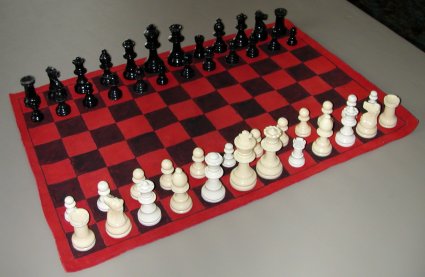The Courier Game

The Courier Game (das Kurierspiel) is a German chess variation which originated in the early 13th century and continued as a popular game for several hundred years. In the mid 1700s it was still being played in the village of Ströbeck, though by 1825 visitors there found it extinct. You'll also see the Courier Game referred to as "Courier Chess."
The game is played on an 8x12 board, with 24 pieces on each side. Each player has a white square in his right-hand corner. Most sources put the king on a square of its own color, the opposite of modern Chess. White's pieces, moving along the back row from left to right, are the rook, knight, bishop, courier, counsellor, king, queen, fool, courier, bishop, knight, and rook.
The rook has the same move as the modern rook, any number of spaces straight on an open rank or file.
The knight has the same move as the modern knight, one space straight and one space diagonal, leaping over any intervening piece.
Next comes the bishop, which has the old medieval bishop's move: two spaces diagonally, neither more nor less, and (like the knight) leaping over any intervening piece. You'll notice, I use a different piece, not a bishop, to represent the bishop in the Courier Game.
This is because the piece that comes next, the courier, moves exactly like our modern bishop, any number of spaces diagonally along an open diagonal. Hence the piece I use to represent the courier is a bishop. Historically speaking, the courier was the first piece to have the unlimited diagonal move of today's bishop.
Next in from the courier come two other new pieces. The mann or counsellor— that biggish piece next to the king— moves just like the king, one space in any direction, only it is a fighting piece: it can be captured like any other piece, and unlike the king it is not subject to check. The schleich or fool— the small rook next to the queen— moves like a rook, but only one space at a time: one space forwards, backwards, or sideways.
Finally we have the king, which moves like our modern king, one space in any direction. And the queen moves like the old medieval queen, one space diagonally.
The pawns move one space straight forward, and capture one space diagonally forward. They can't move two spaces on their first move (partial exception in a moment), and thus there is no capturing a pawn en passant.
In the Courier Game the standard opening is for each player to advance his queen's pawn and rook's pawns two spaces, and his queen to queen three. After these initial four exceptional moves, the game proceeds with pieces moving normally.
There is no castling. Of course, the object of the game is to put the other player's king in checkmate. The rule for stalemate in the Courier Game is unknown; until the 19th century the status of stalemate varied considerably in Chess.
The rule for pawn promotion is also unknown: on reaching the eighth rank, the pawn could perhaps have been promoted to the relatively weak queen, as in medieval Chess. Or, as H.J.R. Murray has suggested, perhaps pawn promotion followed the complicated rules of another Chess variation played in Ströbeck: on reaching the eighth square, the pawn had to make three "joyleaps" backward to the 6th, 4th, and 2nd squares to be promoted to queen. These joyleaps did not have to occur on consecutive turns, and the pawn could not capture, or leap over pieces, while moving backwards. While on the 8th square the pawn was immune from capture.
Back in the old days it was held that the courier was the most powerful piece in the game, though actually the rook must have been stronger.
I made my set for the Courier Game in high school back in the early 70s, when I turned out sets for a number of Chess variations as an art project. The board is red suede leather, with the black squares drawn on in India ink. The pieces were cannibalized from several sets of chessmen.
The Courier Game is slow compared to modern Chess, but nonetheless it's quite playable.
Labels: games








0 Comments:
Post a Comment
<< Home